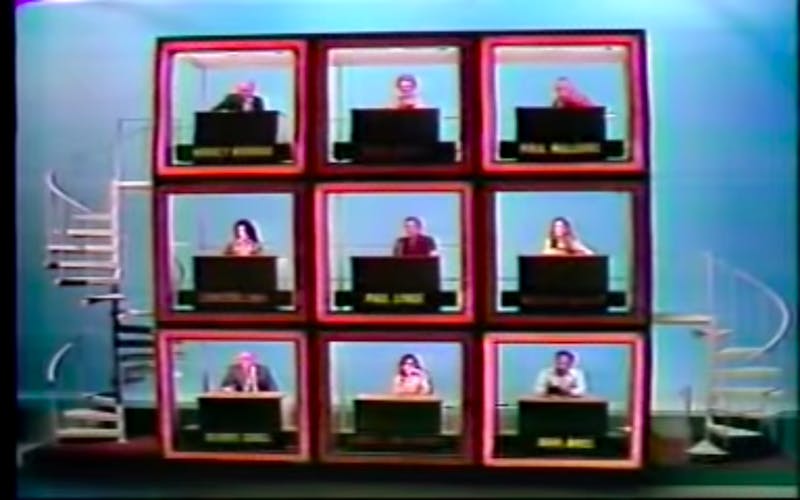In 2011, a New York Times piece announced the rise of videoconferencing. Skype had been around since 2003, but Microsoft had just bought the company, and a “critical mass” of businesses was starting to host meetings virtually. The article quoted a psychiatrist named Thomas Lewis warning of our oncoming isolation: “The more communications channels to the world in our living room, the less likely we are to leave the living room.” It has turned out, of course, the other way around.
Against the dramatic backdrop of global pandemic, a new medium waltzes to ascendancy: the multiperson video chat. Be it in Zoom or Houseparty or Google Hangout, on smartphone or laptop or tablet, the virtual social event has brought succor to a lot of lonely people.
Surprisingly, the very tools that endear videoconferencing to managers also make them work for parties. As a friend pointed out to me, only one person can talk at a time on a video call, which tunes the conversational frequency to something closer to dinner party than bar-shouting. Another friend reports that her Zoom book group was the first time she had achieved full distraction from the pandemic since isolation began.
Yet another friend told me that she likes how “you aren’t expected to be too involved.” At the virtual dance party, for example, one of our number sat quietly, painting, while another secretly played solitaire. This represents a marked reduction in the engagement level usually required to formally hang out with somebody, and perhaps that is progress of a kind.
Having only used Zoom for work meetings, I had associated the group visual call with the performance of duty or obligation. I also had long-standing negative associations with the little rectangle with myself in it, the one that lurks down at the corner of the screen and summons me, over and over, to witness my tiny self imprisoned in a tiny box. It seemed like the opposite of all that was good about the internet, then: anonymity, boundlessness.
But that was the past. In fact, as soon as I rescheduled a standing after-work drinks date into a virtual equivalent, it was the look of Zoom that won me over, the sheer abundance of it. You see all your friends stacked in a grid view, their faces piled in rows as if they all live in different parts of some kind of Richard Scarry apartment building. And you live there, too!

It all feels like an old game show, like Hollywood Squares. That nostalgic mist is only thickened by the inevitably poor images and sounds coming from some of these rectangles. Cutting across this woolly and sentimental aesthetic, however, is the satisfying element of enjoying or even discovering a truly futuristic experience. Back in 2011, the Times compared video chatting to jet packs, in terms of unimaginability: Look at us acting out that cyberspace fantasy now, as if inside the Tron mainframe.
That charm pulled me into the Zoom party harder than my self-consciousness pushed me away. There’s something cool about the montage effect of these multiple channels on a single screen, reminiscent of a 1970s action movie introducing its ass-kicking heroines. In cinema, this style is called “spatial montage” or “windowing.” In the language of Michel Betancourt, it’s a kind of split-screen editing defined by the “presentation of multiple images (shots) simultaneously on screen, all juxtaposed in a fashion that has direct parallels in both graphic design and comics.”
The gridded screen has a noble lineage. In the title sequence for the 1966 film Grand Prix, the screen splits into a nine-segment grid, splintering our attention between the driver’s head, the quivering indicator on a dial, a wrench leaning into a nut. The effect of these “multichannel” grids in Grand Prix is terrifying. It takes this dreadful vibrating apparatus of a car and separates it into discrete elements, like a Cubist painting.

This windowing effect looked shockingly modern in the late 1960s and early ’70s: You can see it used in The Thomas Crown Affair, Airport, and—in a lovely avant-garde form, involving inset shots of different sizes and shapes—in The Andromeda Strain. It’s a neat movie device, not least because it works to show the beauty of the rectangle shape as a part of cinema, as its fundamental architecture. It’s as if the screen itself had come alive and started to make its own biopic.
That sense of humming potential flows into the video chat ambience, which for me suits the party’s necessary vibe of togetherness and love. Underneath my happy experience of Zoom, however, there is the other story of our emergency shift to video-chatting: the one about private corporations taking over almost all aspects of human communication, then turning our data into money.
From that perspective, the Zoom boom looks more like a grim reminder of how branded all of this is, how rich somebody must be getting off our distress. The whole reason we’re having these parties is to forget about how bad the world is, for a minute—to drift off through a screen into a nicer imaginary world. Seems like you can’t have one without the other.
